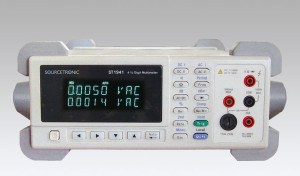Digital multimeter
A digital multimeter is a device for measuring various electrical characteristics, hence the term “multi”. Depending on the design and functionality, a multimeter can be used to measure DC voltages and currents, AC voltages and currents, frequencies, capacities, resistances or temperatures. A test for the operation of transistors, diodes, or the electrical continuity can also be performed with the device. In contrast to the mobile multimeter, the digital multimeter is designed for stationary use at a laboratory or workshop. The typical dimension of a tabletop device is about 25 cm wide, 30 cm in depth and with a height of about 10 cm. Users of the digital multimeter usually secure it in the front of the bench on a small, elevated stand so that it is positioned for easy reading and use.
Design and operation of Digital Multimeter
 The display showing the measured values, such as the voltage or resistance, are displayed on the digital multimeter on the front panel display. These mulitmeters often have a digital, illuminated version which offers the highest readability. In general, to operate the multimeter, a main voltage of 230V is necessary and some devices can also operate in an alternate battery mode. Most of the digital multimeters can be connected via a USB or RS-232 cable to a computer. With the appropriate software, long-term measurements of different readings can be recorded and it is possible for the values to be displayed graphically using visualization software. In addition, it can be printed out and it is also possible that the measured values and time series can be exported to other devices with using interfaces.
The display showing the measured values, such as the voltage or resistance, are displayed on the digital multimeter on the front panel display. These mulitmeters often have a digital, illuminated version which offers the highest readability. In general, to operate the multimeter, a main voltage of 230V is necessary and some devices can also operate in an alternate battery mode. Most of the digital multimeters can be connected via a USB or RS-232 cable to a computer. With the appropriate software, long-term measurements of different readings can be recorded and it is possible for the values to be displayed graphically using visualization software. In addition, it can be printed out and it is also possible that the measured values and time series can be exported to other devices with using interfaces.
The multimeters can differ significantly in their performance ratings. Therefore, different values should also be studied and accurately compared when choosing the right functionality for the specific needs of the unit. The possible ranges for the individual sizes are of particular importance. When using the multimeter for a DC voltage measurement, the typical values are from about 400 mV up to 1000 V with resistances of up to 40 megohms can be measured in the range of 400 ohms. Frequencies of the order of 50 Hz to 100 KHz can also be measured. Additionally, what must be considered are the tolerance limits that indicate the reliability of the measurement in these ranges.
Many of the devices offer an automatic range selection: the unit automatically turns possible ranges on. In less convenient devices, this choice must be done manually with a switch. This can be an uncomfortable position when both hands are needed to keep the measuring points stable. The measurement process is simple with a digital multimeter, the cables included connect to the front panel jacks and then the measurement points of the circuit or component to be tested (transistor or diode) can be shown as a measurement on the display. Many digital multimeters have a “HOLD” button which can freeze the last measured value so that the display does not immediately have a value of zero after disconnecting the wires.
« Back
